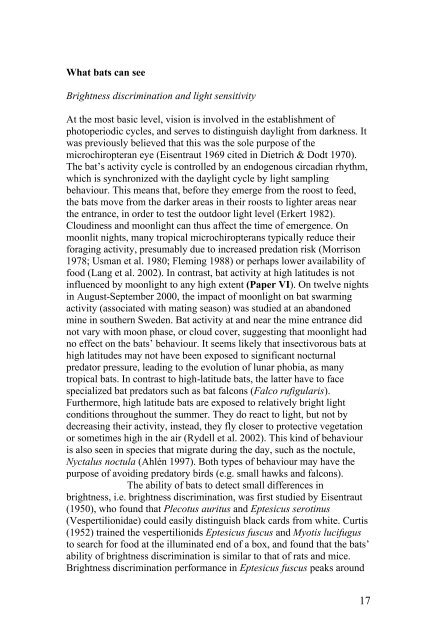Vision in echolocating bats - Fladdermus.net
Vision in echolocating bats - Fladdermus.net
Vision in echolocating bats - Fladdermus.net
You also want an ePaper? Increase the reach of your titles
YUMPU automatically turns print PDFs into web optimized ePapers that Google loves.
What <strong>bats</strong> can see<br />
Brightness discrim<strong>in</strong>ation and light sensitivity<br />
At the most basic level, vision is <strong>in</strong>volved <strong>in</strong> the establishment of<br />
photoperiodic cycles, and serves to dist<strong>in</strong>guish daylight from darkness. It<br />
was previously believed that this was the sole purpose of the<br />
microchiropteran eye (Eisentraut 1969 cited <strong>in</strong> Dietrich & Dodt 1970).<br />
The bat’s activity cycle is controlled by an endogenous circadian rhythm,<br />
which is synchronized with the daylight cycle by light sampl<strong>in</strong>g<br />
behaviour. This means that, before they emerge from the roost to feed,<br />
the <strong>bats</strong> move from the darker areas <strong>in</strong> their roosts to lighter areas near<br />
the entrance, <strong>in</strong> order to test the outdoor light level (Erkert 1982).<br />
Cloud<strong>in</strong>ess and moonlight can thus affect the time of emergence. On<br />
moonlit nights, many tropical microchiropterans typically reduce their<br />
forag<strong>in</strong>g activity, presumably due to <strong>in</strong>creased predation risk (Morrison<br />
1978; Usman et al. 1980; Flem<strong>in</strong>g 1988) or perhaps lower availability of<br />
food (Lang et al. 2002). In contrast, bat activity at high latitudes is not<br />
<strong>in</strong>fluenced by moonlight to any high extent (Paper VI). On twelve nights<br />
<strong>in</strong> August-September 2000, the impact of moonlight on bat swarm<strong>in</strong>g<br />
activity (associated with mat<strong>in</strong>g season) was studied at an abandoned<br />
m<strong>in</strong>e <strong>in</strong> southern Sweden. Bat activity at and near the m<strong>in</strong>e entrance did<br />
not vary with moon phase, or cloud cover, suggest<strong>in</strong>g that moonlight had<br />
no effect on the <strong>bats</strong>’ behaviour. It seems likely that <strong>in</strong>sectivorous <strong>bats</strong> at<br />
high latitudes may not have been exposed to significant nocturnal<br />
predator pressure, lead<strong>in</strong>g to the evolution of lunar phobia, as many<br />
tropical <strong>bats</strong>. In contrast to high-latitude <strong>bats</strong>, the latter have to face<br />
specialized bat predators such as bat falcons (Falco rufigularis).<br />
Furthermore, high latitude <strong>bats</strong> are exposed to relatively bright light<br />
conditions throughout the summer. They do react to light, but not by<br />
decreas<strong>in</strong>g their activity, <strong>in</strong>stead, they fly closer to protective vegetation<br />
or sometimes high <strong>in</strong> the air (Rydell et al. 2002). This k<strong>in</strong>d of behaviour<br />
is also seen <strong>in</strong> species that migrate dur<strong>in</strong>g the day, such as the noctule,<br />
Nyctalus noctula (Ahlén 1997). Both types of behaviour may have the<br />
purpose of avoid<strong>in</strong>g predatory birds (e.g. small hawks and falcons).<br />
The ability of <strong>bats</strong> to detect small differences <strong>in</strong><br />
brightness, i.e. brightness discrim<strong>in</strong>ation, was first studied by Eisentraut<br />
(1950), who found that Plecotus auritus and Eptesicus serot<strong>in</strong>us<br />
(Vespertilionidae) could easily dist<strong>in</strong>guish black cards from white. Curtis<br />
(1952) tra<strong>in</strong>ed the vespertilionids Eptesicus fuscus and Myotis lucifugus<br />
to search for food at the illum<strong>in</strong>ated end of a box, and found that the <strong>bats</strong>’<br />
ability of brightness discrim<strong>in</strong>ation is similar to that of rats and mice.<br />
Brightness discrim<strong>in</strong>ation performance <strong>in</strong> Eptesicus fuscus peaks around<br />
17


